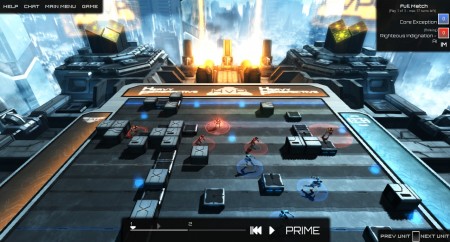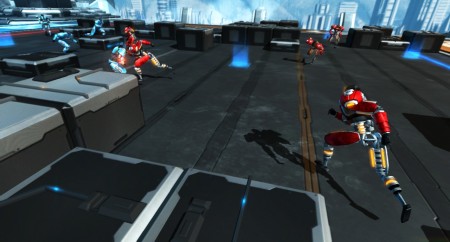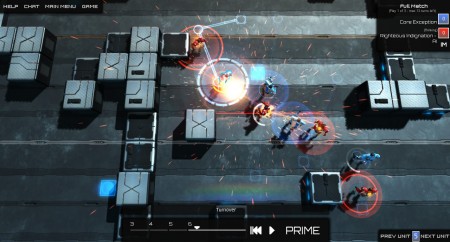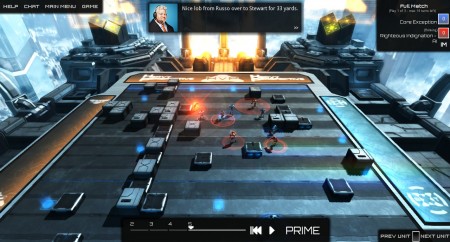Early Access – Frozen Endzone
Frozen Endzone is a simple game. You have a team of players. They have a team of players. You both have endzones. There is one ball. All you have to do is get the ball from one end of the pitch to the other, throwing, passing, tackling, and generally ensuring that the other team doesn’t get their dirty mitts on your precious ball. It’s a simple team-based ball game, just like your school used to make you play (with 200% less mud).
As always, there is just one little catch.
It’s agonising. That pitch? It’s covered in crates and pathways, offering up multiple routes of ambush and attack. You can pick one, but how do you know they won’t already be blocking off the other end? How do you know which is the right one? How do you predict what that smug bastard coordinating the other side will do? You’ve not got enough players to cover all ends, all eventualities. But you have to do something.

You see, Frozen Endzone works like developer Mode 7’s previous offering Frozen Synapse. It’s a turn-based game, but both teams move at once. You can’t just wait around and see what your (momentary) mortal enemy is going to do, you can’t strategise after the fact, safe in the knowledge that the opposition is actually, definitely, going to be where you think they are.
All that has to happen for a turnover is to intercept a pass or make a successful tackle, which itself as a simple as smashing two players together. The dynamic changes, and you suddenly scramble away from the attack, cursing yourself for being too aggressive, for not keeping reserves. You watch, helplessly, as that accursed robot edges further and further away, until, at the last moment, the paths of one of your players and the carrier intersect in a flash of sparks and the ball is yours again. Then the dynamic changes, yet again.
The essence of Frozen Endzone is in this constant series of hesitant second guesses and nail-biting runs in the shower of sparks as two players collide, in desperately trying to out think your opponent in the gaps between turns. It’s a core experience that’s supported by simple, moreish, mechanics that allow for a degree of nuance. You move your team by setting waypoints. A player with the ball can throw it, or make a run for the endzone. A player without the ball can block other players, intercept the ball or tackle the player with the ball. The nuance comes in with a few small, but crucial, elements. You can add a time delay to waypoints, you cannot make a run and still throw the ball and, most importantly, turns last until the next significant event. The game becomes something of an exercise in brinkmanship and timing. You could grab the ball immediately, but do you delay until the team is in position, drawing your opponent closer and closer in, until you have to grab the ball and stop the play.

The importance of this little detail of turn-based timekeeping cannot be understated. It adds tension to the turns where you’re on the attack, and it makes watching the other team draw further and further ahead all the more agonising. It adds a real sense of impact to every significant movement of the game. In a way, it makes Frozen Endzone actually feel like a sports game, rather than an exercise of shepherding a circle holding a dot to the other side of a square.
All this is aided by the visual design. The grey, industrial pitch is set against spectacular backdrops of gigantic foundries and futuristic cityscapes reminiscent of Mirror’s Edge’s clean aesthetic. The players themselves are well detailed, with a mechanical look that fits with the exaggerated animations. What really works, however, are the crunchy, almost explosive, tackling and blocking animations, which ensure that turns often end in cascades of sparks.

Whilst it only offers single matches, online or against the competent AI, there is a wealth of customisation options for the match rules and it currently boasts a reasonably well populated community. It’s a remarkably complete experience at the moment, despite the Early Access label.
That’s not to say that I’m entirely sold on Frozen Endzone. The turns themselves play out in a kind of TV camera mode, which can make actually watching them slightly difficult. Granted, you can rewatch the turns to see what happens, but, at least for me, it detracts slightly from the impact of the action. Similarly, the angled camera perspective also makes strategising difficult at times. It is possible to zoom into a top-down display, but this puts you just a little bit to the action.
Other gameplay elements, such as the blue zones that can be run through by the player with the ball for extra points on touchdown or the player stats, don’t quite work. For the blue zones, it’s perhaps because passing through them doesn’t produce the same crunch as passing or tackling. Similarly, the stats are somewhat indistinct. They certainly have an effect, but it can be difficult to gauge the precise effect.

For an Early Access game, Frozen Endzone is remarkably cohesive and so I can’t really see Mode 7 producing anything other than a solid, moreish, game. Given that Mode 7 are promising more multiplayer modes, leagues, single-player story and in-depth player customisation, it may well end up with a meta-game and superstructure to match the solid core experience.
As it stands, it’s a tense, compact experience that allows for a reasonably quick tactical fix. No doubt it has a promising career ahead of it.